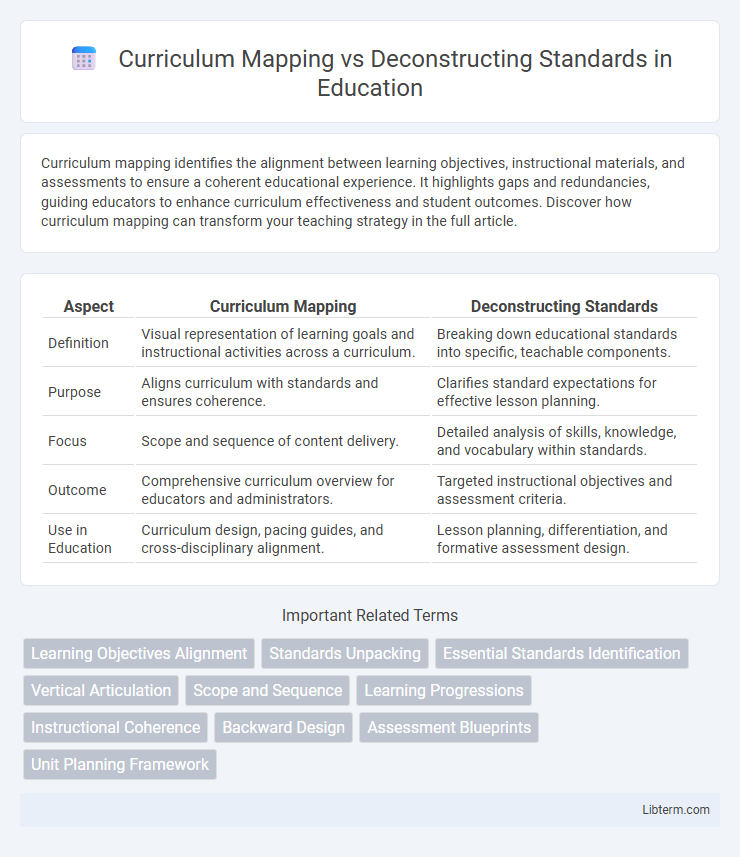Curriculum mapping identifies the alignment between learning objectives, instructional materials, and assessments to ensure a coherent educational experience. It highlights gaps and redundancies, guiding educators to enhance curriculum effectiveness and student outcomes. Discover how curriculum mapping can transform your teaching strategy in the full article.
Table of Comparison
| Aspect | Curriculum Mapping | Deconstructing Standards |
|---|---|---|
| Definition | Visual representation of learning goals and instructional activities across a curriculum. | Breaking down educational standards into specific, teachable components. |
| Purpose | Aligns curriculum with standards and ensures coherence. | Clarifies standard expectations for effective lesson planning. |
| Focus | Scope and sequence of content delivery. | Detailed analysis of skills, knowledge, and vocabulary within standards. |
| Outcome | Comprehensive curriculum overview for educators and administrators. | Targeted instructional objectives and assessment criteria. |
| Use in Education | Curriculum design, pacing guides, and cross-disciplinary alignment. | Lesson planning, differentiation, and formative assessment design. |
Introduction to Curriculum Mapping and Deconstructing Standards
Curriculum mapping provides a visual framework for aligning instructional content, assessments, and standards to ensure coherent and consistent learning experiences across grade levels. Deconstructing standards involves breaking down complex educational standards into specific, teachable components, clarifying learning targets and skills required for student mastery. Both approaches enhance curriculum design by promoting clarity, alignment, and targeted instructional planning.
Defining Curriculum Mapping
Curriculum mapping is a systematic process that visually aligns instructional content, assessment methods, and learning objectives across grade levels or courses to ensure coherence and consistency in education. It involves creating a detailed framework that highlights when and how standards are taught, facilitating gap analysis and curriculum improvement. This structured approach contrasts with deconstructing standards, which breaks down individual standards into specific skills or learning targets for instructional planning.
Understanding the Process of Deconstructing Standards
Deconstructing standards involves breaking down educational standards into specific, manageable learning targets to clarify what students need to know and be able to do. This process enhances curriculum mapping by aligning instructional goals with assessments and daily lessons, ensuring consistency and coherence across grade levels. Effective deconstruction requires collaboration among educators to interpret standards accurately and translate them into actionable teaching strategies.
Key Objectives: Mapping vs. Deconstruction
Curriculum mapping centers on aligning course content with key objectives to ensure comprehensive coverage of standards across grade levels, creating a clear instructional roadmap. Deconstructing standards breaks down complex educational standards into specific, measurable learning targets to clarify expectations and support targeted instruction. Mapping emphasizes sequence and coherence, while deconstruction focuses on unpacking standards for deeper understanding and precise skill development.
Step-by-Step Guide to Curriculum Mapping
Curriculum mapping involves systematically aligning learning objectives, instructional activities, and assessments to ensure coherent educational progression across grades. A step-by-step guide to curriculum mapping includes identifying curriculum standards, selecting key concepts, sequencing content logically, and continuously reviewing maps for alignment and mastery gaps. Deconstructing standards complements this by breaking down complex standards into teachable components, enhancing precision in curriculum maps and targeted instruction.
Deconstructing Standards: Methods and Approaches
Deconstructing standards involves breaking down complex educational standards into specific, manageable learning objectives to ensure clarity and alignment in curriculum design. This process typically employs methods such as identifying key concepts, performance indicators, and cognitive demands embedded within the standards to create targeted instructional goals. Approaches often integrate backward design principles, where educators analyze standards to develop assessments and instructional activities that directly address the essential skills and knowledge required for student mastery.
Benefits and Challenges of Curriculum Mapping
Curriculum mapping offers the benefit of providing a clear, comprehensive overview of what is being taught across grade levels, ensuring alignment with standards and identifying gaps or redundancies in instruction. It promotes collaboration among educators, enabling consistent pacing and coherent learning progressions, but challenges include the time-intensive process of creating and maintaining accurate maps and potential resistance to change from staff. While deconstructing standards focuses more narrowly on breaking down complex learning goals into manageable components, curriculum mapping provides a broader framework that supports school-wide curriculum coherence and continuous improvement.
Advantages and Limitations of Deconstructing Standards
Deconstructing standards enables educators to break down complex learning objectives into precise, teachable components, enhancing clarity and targeted instruction. This method promotes deeper understanding of content expectations but can be time-consuming and requires significant expertise to avoid oversimplification or misalignment with broader curriculum goals. While it fosters focused skill development, it may limit flexibility in addressing interdisciplinary themes compared to curriculum mapping.
Curriculum Mapping vs. Deconstructing Standards: Comparative Analysis
Curriculum mapping systematically aligns instructional content with learning objectives to ensure comprehensive coverage and coherence across grade levels. Deconstructing standards involves breaking down complex academic standards into specific, teachable components that clarify expectations for both educators and students. Comparative analysis reveals curriculum mapping provides a macro-level view for curriculum continuity, while deconstructing standards offers micro-level clarity essential for targeted instruction and assessment design.
Best Practices for Implementing Both Approaches
Curriculum mapping involves systematically aligning lessons and assessments with state standards to ensure comprehensive coverage and coherence, while deconstructing standards breaks down complex learning goals into clear, measurable objectives for targeted instruction. Best practices for implementing curriculum mapping include regular collaboration among educators to update and refine maps based on student data and instructional feedback, and using digital tools for real-time adjustments. For deconstructing standards, effective strategies emphasize teacher training to accurately dissect standards into teachable components and integrating these components into lesson planning to ensure depth of understanding and skill mastery.
Curriculum Mapping Infographic

 libterm.com
libterm.com